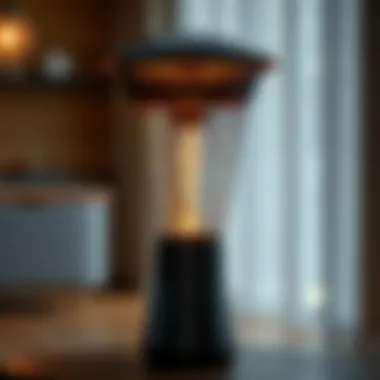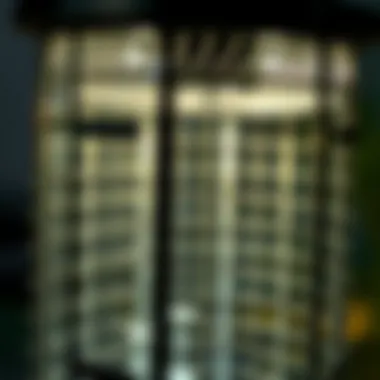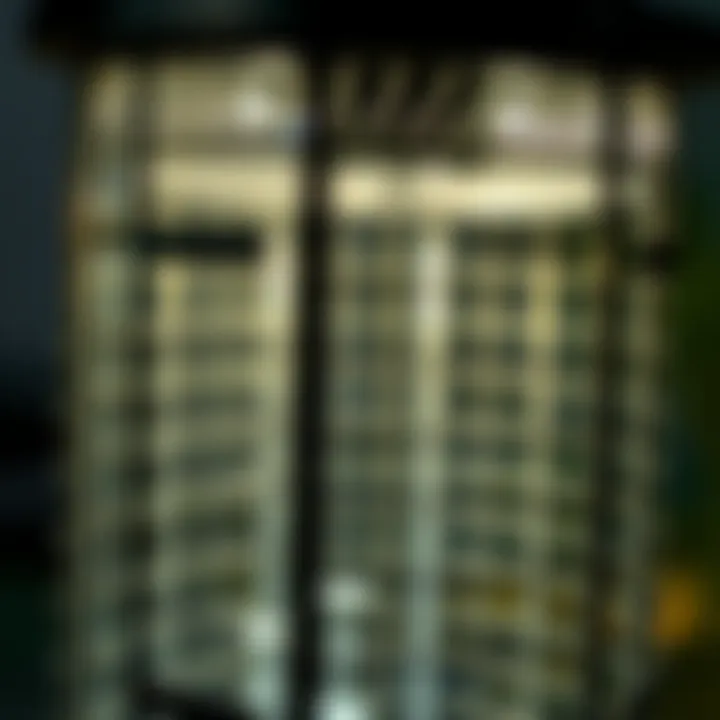Top 5 Mosquito Zappers Reviewed for Effective Pest Control


Intro
Mosquitoes are more than just a nuisance; they can threaten our comfort and health in our homes and outdoor spaces. Understanding the measures we can take against their invasion is crucial for maintaining a peaceful living environment. With the advent of mosquito zappers, homeowners have a modern weapon in their pest control arsenal. This guide not only reviews some of the best mosquito zappers on the market but also explores the mechanics behind them, offers insightful comparisons based on user experiences, and highlights effective strategies for integrating these devices into your home. By thoroughly examining the options available, this article aims to empower readers to make informed choices that suit their unique needs.
In the sections that follow, we will dive into pest identification, prevention strategies, and the various treatment options that complement the use of mosquito zappers. Placing emphasis on practical insights and thorough evaluations, this guide will serve as a useful resource for housewives and homeowners alike.
Preamble to Mosquito Zappers
Mosquito zappers have become a household term for those who have had their evenings spoiled by buzzing pests. They offer a glimmer of hope, a potential escape from the incessant annoyance that mosquitoes bring as they swarm around outdoor fun or even inside your living space. This section aims to delve into the significance of mosquito zappers within the context of effective pest control, illustrating why understanding these devices is essential for homeowners looking to enhance their comfort at home.
Understanding Mosquito Behavior
To appreciate the efficacy of mosquito zappers, one needs a grasp of mosquito behavior. These small yet persistent insects are attracted to carbon dioxide and body heat, drawn in by the scents of sweat and warmth. They come alive during certain times of day, notably dawn and dusk, when many are unwinding outside and unknowingly becoming a banquet for these pests.
Moreover, mosquitoes can breed in surprisingly small water droplets, making puddles and even plant saucers prime real estate for their lifecycle. This means that controlling their population isn't just about zapping adults; it’s about understanding the environment they thrive in.
While mosquitoes can be fiercely annoying, it helps to remember that not all species are created equal. Some are more aggressive, while others are more passive, choosing to nibble rather than feast. The varying behavior gives rise to the need for varied methods of control.
The Role of Zappers in Pest Control
Zappers fundamentally operate on the principle of attraction followed by elimination. They often utilize light to lure mosquitoes close enough to deliver a fatal electric shock upon contact. These devices serve multiple purposes in pest control, making them intriguing allies for anyone looking to reclaim their outdoor spaces.
- Effectiveness: Many zappers offer a significant reduction in mosquito populations within a defined space. If placed strategically, they can create a barrier, making the surrounding areas less appealing for these insects.
- Convenience: Unlike sprays or lotions that need frequent reapplication, zappers require minimal maintenance once set up, making them a hassle-free option for busy households.
"Understanding how zappers work can make the difference between enjoying a peaceful evening outdoors and being swarmed by pests."
- Complementary Use: Zappers can work in tandem with other pest control strategies, such as eliminating standing water and employing natural repellents, to create a more robust approach to managing mosquito populations.
In summary, mosquito zappers are not just devices; they are an integral component in the broader conversation about maintaining living environments free from pests. Their understanding helps homeowners make informed decisions about pest management strategies, particularly in the warmer months when mosquitoes are most active.
Key Features to Consider
When it comes to selecting the right mosquito zapper, the specific features of each model carry significant weight in determining overall performance. These features directly impact how effectively the device can do its job. Knowing what to look for helps homeowners choose zappers that best fit their needs, ensuring a more solid investment in pest control. Here we discuss four critical aspects of mosquito zappers: effectiveness and efficiency, design and portability, safety features, and maintenance requirements.
Effectiveness and Efficiency
Effectiveness refers to how well a mosquito zapper reduces the mosquito population in a given area. An efficient zapper not only attracts these pesky insects but also eliminates them without excessive power consumption. It's essential to consider the technology used in the zapper, like ultraviolet light or carbon dioxide emission, as these affect how well the zapper can lure mosquitoes. A product that combines high attraction to mosquitoes with low energy use could save you money in the long run.
When assessing effectiveness, pay attention to the coverage area of the zapper. Models designed for larger areas may be more suitable for outdoor use, while smaller devices could work well indoors. The ideal zapper should handle the square footage of the space. Always check user reviews and ratings to get insight on how effective a model is in real-world situations.
Design and Portability
Design matters a great deal when it comes to mosquito zappers. A sleek aesthetic can blend in well with outdoor decor, while functional design ensures ease of use. Portability is another factor that shouldn't be overlooked; consider if the zapper has a built-in handle or if it’s lightweight for easy movement between locations.
Some zappers come with features like waterproof casings, which allow outdoor use even during light rain, making them a more flexible option for your backyard or patio.
Top Mosquito Zappers Reviewed


In this section, we delve into the specifics of the top mosquito zappers available today. Each model is examined thoroughly to help consumers make informed decisions. Understanding what each zapper brings to the table is crucial, as the effectiveness can often hinge on nuances like design, operational efficiency, and user experience.
Model A: Comprehensive Overview
Features and Benefits
Model A shines due to its rugged design and powerful lamp. The two-in-one feature of night light and mosquito zapper is highly advantageous, providing functionality beyond mere pest control. Having this versatility can enhance user satisfaction, especially in outdoor settings where ambiance matters. The zapper also covers a wide area, making it a favorite for those who entertain outdoors often.
Pros and Cons
On the upside, Model A has a sturdy build that withstands the elements; however, users should be aware of its relatively noisy operation at times, which might not be ideal for quiet evenings. Some users have found it surprisingly effective, reducing the mosquito population significantly after just a few days of use.
User Testimonials
Feedback from users highlights its efficacy in warmer climates, especially where certain species of mosquitoes thrive. Customers appreciate not just its features but also the design that allows easy cleaning. Many have mentioned they felt a sense of relief having taken back their patios, which adds to its appeal.
Model B: Comprehensive Overview
Features and Benefits
Model B distinguishes itself with a minimalist aesthetic and energy-efficient operation. Featuring a simple plug-and-play setup, this zapper is aimed at users looking for convenience without fuss. It's notable for its low power consumption, which resonates well in environmentally-conscious households.
Pros and Cons
While the energy efficiency is a plus, reviews point out it may not attract as many mosquitoes as its competitors in larger open spaces. This makes it ideal for smaller backyards or indoor use but may fall short in expansive outdoor areas.
User Testimonials
Many recommend Model B for its unobtrusive nature and silent operation, making it good for those living in multi-unit dwellings. Users often express satisfaction with its performance over time, noting a gradual decrease in mosquito sightings within weeks of activation.
Model C: Comprehensive Overview
Features and Benefits
Model C stands out with its eco-friendly materials and UV light technology, designed to lure mosquitoes without harmful chemicals. This feature aligns well with a growing trend toward natural pest control methods. It offers a substantial coverage area, aiding in the reduction of bites during those buggy summer nights.
Pros and Cons
The primary strength lies in its chemical-free operation. However, its reliance on UV light may lead to mixed results based on outdoor light conditions. Some reviewers have stated that its effectiveness seems compromised in well-lit areas.
User Testimonials
Users praise Model C for its sustainability angle, with many indicating they appreciate living in a greener way without sacrificing comfort. Testimonials suggest that consistent use in shaded areas has produced satisfactory outcomes.
Model D: Comprehensive Overview
Features and Benefits


The highlight of Model D is its multi-functionality – it serves as both a mosquito catcher and a decorative piece, making it a striking addition to garden aesthetics. This dual purpose has proven beneficial for homeowners who value both aesthetics and pest control. Its comprehensive design caters to households that demand style without compromise on efficacy.
Pros and Cons
While many celebrate its unique look, some have voiced concerns over the complexity of its setup. This model may not be as straightforward for those who prefer simplicity. Users should also note its higher price point compared to more basic models, but many feel it's justified given its features.
User Testimonials
Feedback often remarks on how Model D has become a conversation starter at gatherings, seamlessly combining functionality with style. Users report being pleasantly surprised at how effective it is while also complimenting its design.
Model E: Comprehensive Overview
Features and Benefits
Model E promises cutting-edge technology with advanced mosquito attraction features and a replaceable UV light bulb that sets it apart. The durability of its design ensures it's built to last, which aligns with consumers looking for a long-term investment in pest control solutions. Its ability to function in diverse environments, from kitchens to gardens, enhances its appeal significantly.
Pros and Cons
This model’s robustness is one of its key strengths. However, while being an effective zapper, it requires regular upkeep for optimal performance. Users should be prepared to periodically change the bulbs, which adds an ongoing cost to ownership.
User Testimonials
Many customers laud Model E’s effectiveness in attracting a variety of mosquito species, often noting that they have seen a decline in mosquito presence soon after purchasing. Testimonials reflect satisfaction not just in performance but also in its ability to blend into home decor seamlessly.
Comparison of the Top Models
When it comes to selecting the best mosquito zapper for your home, a thorough comparison of the top models available is invaluable. This section serves as a pivotal point in the article, allowing readers to navigate through the plethora of choices in a practical manner. By weighing the strengths and weaknesses of various zappers, you can make an informed decision that aligns with your particular pest control needs. The insights offered here can significantly aid homeowners in personalizing their approach to managing these pesky insects.
Performance Metrics
Performance metrics are crucial in assessing the efficacy of mosquito zappers. These metrics offer tangible data on how well a zapper functions in real-world conditions.
- Catch Rate: The number of mosquitoes a device can effectively trap is key. Leading models often provide specifications detailing catch rates, typically expressed as mosquitoes per hour. For example, some top zappers can catch hundreds of mosquitoes in a mere night.
- Range: Different zappers have varied effective ranges. Some models can cover a substantial outdoor area, while others are meant for smaller spaces. It’s important to consider the square footage of your yard or patio when evaluating options.
- Power Source: Whether the zapper runs on electricity, batteries, or solar power can affect both performance and usability. Models powered by traditional electricity may have more robust performance, but battery-operated or solar zappers offer the convenience of portability. This is especially useful if you want to move the device around during gatherings or while gardening.
Collectively, these metrics give a clearer picture of how well a particular model can fend off an army of mosquitoes. For a detailed breakdown of various models' performance metrics, you might consider checking user reviews on platforms like Reddit or specialized home improvement blogs.
Cost Effectiveness
Evaluating cost effectiveness is another vital aspect when choosing a mosquito zapper. This concept goes beyond the initial purchase price and examines the long-term value a model delivers.
- Initial Investment: The upfront cost can vary widely. Premium models may have advanced features, but it’s worth contemplating whether those features are essential for your specific use case.
- Operating Costs: Beyond the purchase price, consider costs like electricity consumption or the need for replacement bulbs. Some zappers require frequent bulb replacements, which can add up over time. Models with energy-efficient designs may save you money in the long haul, especially if they operate continuously during peak seasons.
- Longevity: Durability also factors into cost effectiveness. A zapper that lasts several years provides better value than one that needs replacing after a single season. Reviews often specify how long users have had their devices and whether they've faced any repair issues.
In summary, comparing these elements—performance metrics and cost effectiveness—will ensure that you choose a mosquito zapper that not only meets your immediate needs but also serves you well for years to come. The careful evaluation of models based on these criteria can help you employ a profound strategy for mosquito control in and out of your home.
Practical Considerations for Use
When dealing with mosquito zappers, understanding the practical aspects of their use is not just beneficial—it’s essential. Selecting the right zapper and employing it correctly can significantly affect its effectiveness in managing unwanted pests. This section will focus on specific elements that play a vital role in ensuring that your mosquito control efforts are well-directed and fruitful.


Choosing the Right Location
The placement of your mosquito zapper can make all the difference. It’s not merely about squeezing it into a corner of your patio or porch; instead, location is king when it comes to maximizing its efficiency. Mosquitoes are attracted to various factors, such as carbon dioxide emitted from humans and the warmth of body heat. Here are key considerations to keep in mind when selecting a placement:
- Proximity to Breeding Grounds: Identify areas where mosquitoes breed, such as stagnant water. Position your zapper closer to these spots to lure the pests and intercept them before they infest your space.
- Open Spaces: Zappers work best in open spaces where their range can be fully utilized. Areas with obstructions—like dense vegetation or furniture—can hinder airflow and reduce effectiveness.
- Height Level: Installing zappers at a height that mirrors mosquito flight patterns (approximately 3-5 feet off the ground) tends to yield better results. By placing it at this height, you're more likely to capture these pests as they fly around.
Inspecting your area during high mosquito activity hours (usually dusk and dawn) can help you identify prime locations. Set up a test run to see where zappers attract the most insects; moving it around a bit might lead to surprisingly better performance.
Integrating Zappers with Other Pest Control Methods
While mosquito zappers can be effective on their own, combining them with other pest control methods offers an integrated approach that usually leads to better outcomes. Here are some strategies to consider:
- Use of Repellents: Applying mosquito repellent on your skin and clothing adds another layer of protection. When used alongside a zapper, this mitigates bites and enhances your comfort outdoors.
- Natural Deterrents: Planting mosquito-repellent flora like citronella or marigold around your yard can reduce mosquito presence and complement the zapper's function. It’s a twofold strategy that uses nature to your advantage.
- Regular Maintenance: Maintaining your zapper—cleaning up dead insects and ensuring it's still operational—further enhances its effectiveness. Don't forget to complement this with practices like eliminating standing water, as this can dramatically reduce mosquito breeding.
"Integrating zapper use with other pest control methods serves as an efficient barrier against the unwanted invasion of mosquitoes."
In summary, understanding how to effectively line your mosquito zapper strategy with their proper placement and additional deterrents can markedly improve the quality of your outdoor experience. With the right combination of methods in hand, you can keep those pesky mosquitoes at bay, ensuring a more enjoyable time in your yard.
Environmental Impact of Mosquito Zappers
The discussion surrounding the environmental impact of mosquito zappers cannot be overlooked when consumers explore pest control solutions. It’s crucial to grasp how these devices interact not only with unwanted pests but also with the environment at large. Zappers, while effective, raise several considerations that can influence their overall usefulness and safety.
Non-Target Species
One point of contention with mosquito zappers is their impact on non-target species. These devices attract insects through UV light and often lead to the unintended death of beneficial pollinators like bees and butterflies. The concern arises from high mortality rates among insects that aren't pests.
- Harmful Entanglements: When picking a zapper, one must ponder the balance between efficacy in tackling mosquito populations and the unintentional harm to other insects.
- Biodiversity Considerations: A drop in bee populations can negatively influence plant growth, leading to reduced overall biodiversity. This chain reaction reflects not only a local but also a wider ecological impact, raising alarms among environmental advocates.
- Survivability of Pests: Paradoxically, by decimating non-target insects, zappers might inadvertently encourage mosquitoes’ survival. This is because less competition could lead to a resurgence in populations that are more robust and resistant to control measures.
The implications of non-target species mortality highlight the significance of assessing one’s choice of zappers for a sustainable solution.
Sustainability Considerations
Thinking about sustainability involves evaluating whether your pest control methods can coexist harmoniously with nature. Mosquito zappers typically run on electricity, raising queries about their environmental footprint.
- Energy Consumption: Although zappers are popular, their energy usage can add up. Depending on the model, running a zapper continuously can lead to a noticeable increase in electricity bills and carbon emissions. Opting for energy-efficient models can somewhat alleviate this problem.
- Material Waste: Another aspect is the lifespan of the zappers themselves. Many zappers, after their operational period, end up in landfills, contributing to the global waste problem. Search for brands that offer recyclable components or look for zappers made from sustainable materials.
- Eco-Friendly Practices: Some consumers might integrate zappers into a broader ecosystem of eco-friendly pest management. For instance, combining them with natural repellents or strategic landscaping can diminish the reliance on these devices alone, promoting a healthier environment.
In summary, by acknowledging these potential non-target species impacts and evaluating sustainability, consumers can make informed choices while maintaining the delicate balance that nature demands.
In moving forward, it’s essential for housewives and homeowners alike to weigh the practicality of mosquito zappers against their ecological consequences. Only by being mindful of both the benefits and drawbacks can one truly ensure that pest control approaches contribute positively to home and health.
End
In the grand scheme of pest control, the selection of an appropriate mosquito zapper holds significant weight. This article has navigated through the various dimensions surrounding this crucial home device, illuminating aspects that go beyond just killing these pesky insects. Understanding the performance and design of different zappers empowers homeowners to make choices tailored to their unique situations.
Final Thoughts on Selection
When it comes to choosing a mosquito zapper, a few key elements merit consideration to ensure that the investment pays off. The effectiveness of the device in a given environment hinges on its design and the technology employed. Some zappers lure mosquitoes through light, while others may use carbon dioxide or heat. Knowing which method works best for your specific yard or indoor space can indeed make a world of difference.
In terms of safety, opt for models with features aimed at protecting not only humans but also pets and beneficial insects. Remember that while continuity in pest control is beneficial, a balanced approach that integrates zappers with natural repellents or traps might yield better results in the long run.
Additionally, regular maintenance can’t be stressed enough. Cleaning the device ensures optimum performance. Sometimes what seems like a failure of the device can just be a build-up of debris blocking the mechanism.
Investing time in understanding your needs will lead to a much more pleasant mosquito-free existence.



